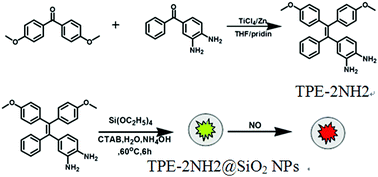Silica nanoparticles based on an AIE-active molecule for ratiometric detection of RNS in vitro
Abstract
Nitric oxide (NO), known as a reactive nitrogen species (RNS), has been considered to be a significant factor in many cell-related biological processes. There is a great desire to develop fluorescent probes that can highly sensitively and selectively detect NO in living cells. Herein, a fluorescent probe, a tetraphenylethene (TPE) derivative TPE-2NH2, with aggregation induced emission (AIE) properties was designed and synthesized. Then silica nanoparticles based on TPE-2NH2 were fabricated for ratiometric detection of NO in vitro with high sensitivity and selectivity. In the presence of NO, the fluorescence of the silica nanoparticles changes from 519 nm (green) to 655 nm (red) because of the chemical reaction between NO and o-phenylenediamine in TPE-2NH2. The silica nanoparticles exhibited very high sensitivity and selectivity towards NO in aqueous buffer, and the response time was as short as 5 minutes. Moreover, the silica nanoparticles can also highly sensitively and selectively respond to NO produced in living cells. When MCF-7 cancer cells were activated by lipopolysaccharides (LPS), which can effectively induce the production of NO, the red emission signal of the silica nanoparticles obviously increased. This demonstrated that the silica nanoparticles showed fine imaging contrast towards NO in MCF-7 cancer cells, which provides a facile tool to detect intracellular NO.



 Please wait while we load your content...
Please wait while we load your content...